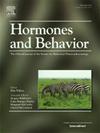基于可塑性行为作用的两种双亲本稚鱼(转录稚鱼和玛利稚鱼)类固醇激素水平变化:祖先调节假说的检验
IF 2.4
3区 医学
Q2 BEHAVIORAL SCIENCES
引用次数: 0
摘要
跨性别转移描述了一种情况,即一种性别在可塑性或进化过程中获得了另一种性别的表型值。这一过程的潜在调节机制通常被认为与性别偏向的激素调节有关,但明确的经验检验尚未进行。最近,祖先调节假说(AMH)被提出作为一个框架来理解跨性别转移背后的激素调节。我们利用两种双亲本丽鱼(Julidochromis transcriptus)和marlieri丽鱼(Julidochromis marlieri)的行为变化来测试跨性别转移发生时激素的变化,并提供AMH的经验测试。一个物种,J. transcriptus,通常形成雄性较大的配对,这通常被认为是祖先的条件;然而,当雌性是一对中较大的个体时,它们会采取雄性的行为。另一个物种,J. marlieri,通常会形成雌性更大的配对,这是一种跨性别的转移,但当非典型配对时,也会改变行为。我们给两个物种的雄性和雌性分别提供大的和小的伴侣,并测量它们的行为和激素变化,从而建立了成对关系。我们发现雌性J. transcriptus在成为大伴侣时11-酮睾酮(11-KT)增加,11-KT和雌二醇(E2)与大伴侣的行为相关。虽然行为确实与睾酮有关,但我们没有发现任何基于体型或性别的激素水平变化。这些结果为AMH框架的预测提供了合格的支持,即通过调节循环激素来调节激素信号可以发生跨性别转移。本文章由计算机程序翻译,如有差异,请以英文原文为准。
Changes in steroid hormone levels based on a plastic behavioral role in two biparental cichlids, Julidochromis transcriptus and Julidochromis marlieri: A test of the Ancestral Modulation Hypothesis
Cross-sexual transfer describes the situation when one sex takes on the phenotypic values of the other sex, either plastically or over evolutionary time. The underlying regulatory mechanisms of this process have been generally assumed to be related to sex-biased hormonal regulation, but explicit empirical tests have not been conducted. More recently, the Ancestral Modulation Hypothesis (AMH) has been proposed as a framework to understand the hormonal regulation that underlies cross-sexual transfer. We leverage the behavioral changes in two species of biparental cichlid, Julidochromis transcriptus and Julidochromis marlieri, to test hormonal changes when cross-sexual transfer occurs and provide an empirical test of the AMH. One species, J. transcriptus, typically forms male-larger pairs, which is generally considered to be the ancestral condition; yet females take on male behaviors when they are the larger individual in the pair. The other species, J. marlieri, typically forms female-larger pairs, a cross-sexual transfer, but can likewise shift behaviors when paired atypically. We established pairs by giving males and females of both species both larger and smaller partners and measured behavioral and hormonal changes. We found J. transcriptus females increased 11-ketotestorerone (11-KT) when becoming the larger partner and 11-KT and estradiol (E2) correlated with behaviors associated with the larger partner. We did not find any changes in hormone levels based on size or sex in J. marlieri, though behaviors did correlate with testosterone (T). These results provide qualified support for the tested prediction from the AMH framework that cross-sexual transfer can occur by coopting hormonal signaling by adjusting circulating hormones.
求助全文
通过发布文献求助,成功后即可免费获取论文全文。
去求助
来源期刊

Hormones and Behavior
医学-行为科学
CiteScore
6.70
自引率
8.60%
发文量
139
审稿时长
91 days
期刊介绍:
Hormones and Behavior publishes original research articles, reviews and special issues concerning hormone-brain-behavior relationships, broadly defined. The journal''s scope ranges from laboratory and field studies concerning neuroendocrine as well as endocrine mechanisms controlling the development or adult expression of behavior to studies concerning the environmental control and evolutionary significance of hormone-behavior relationships. The journal welcomes studies conducted on species ranging from invertebrates to mammals, including humans.
 求助内容:
求助内容: 应助结果提醒方式:
应助结果提醒方式:


